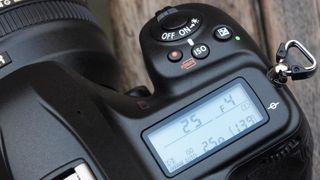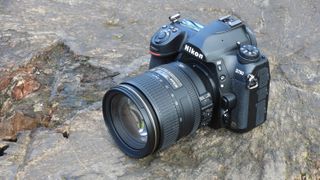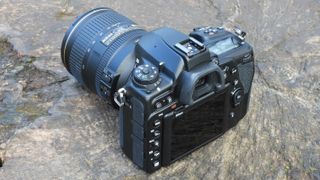TechRadar Verdict
We hear a lot of talk about the death of the DSLR, and the unstoppable rise of mirrorless. But DSLRs remain the best choice for many photographers, particularly those who have existing lenses or honed their craft with optical viewfinders – and the D780 is one of the best full-frame options around. It combines great image quality, a weather-proof build, superb battery life and modern autofocus skills. It's a shame there's no in-body image stabilization and it's currently pretty pricey, but the D780 is otherwise a superb all-round DSLR.
Pros
- +
Plenty of direct access controls
- +
Tilting touch-sensitive screen
- +
Dual card slots
- +
Fast live-view focusing
- +
Great battery life
Cons
- -
Big and heavy
- -
Expensive
Why you can trust TechRadar
The Nikon D780 is perhaps the best example yet of a DSLR reinventing itself for the mirrorless age. It's a very traditional-looking full-frame camera with an optical viewfinder, but underneath that old-school skin lies some of the same tech that you'll find in its cutting-edge Nikon Z6 cousin. In other words, it's something of a DSLR-mirrorless hybrid.
When Nikon and Canon finally relented and committed to their Z Series and EOS R mirrorless systems, fans of optical viewfinders and generous battery lives were naturally worried that the days of new DSLRs were behind them. But the D780 proves that Nikon isn't abandoning the DSLR – in fact, if you have a stash of F mount lenses or just prefer the way a DSLR handles, it might just be one of the best full-frame cameras the company has made so far.
Designed to sit alongside rather than fully replace the older Nikon D750, this is Nikon’s 'entry-level' full-frame model, sitting below the D850 and offering something for those who don’t need mega-high resolution, but who still want a good all-rounder.
With Nikon suggesting that it will run its mirrorless and DSLR offerings in parallel to each other, it’s possible that we might see other new DSLR models with mirrorless technology – for example, an equivalent to the APS-C Nikon Z50. But if it's full-frame shooting you're after, the D780 is a very compelling new option, and is indeed one of the best DSLR cameras you can buy right now.

Nikon D780 release date and price
The Nikon D780 is on sale now and is available either body-only or with the 24-120mm f/4G ED VR kit lens. The body-only cost is £2,199 / $2,299.95 / AU$3,898, while the kit lens bundle will set you back £2,619 / $2,799.95 / AU$4,698.
Right now, that compares unfavorably with the Nikon Z6, which can be picked up for £1,599/ $1,796/ AU$2,699 (body only), or £2,099/ $2,396/ AU$3,899 with a 24-70mm f/4 kit lens. Still, it's worth bearing in mind that the Z6 has been on the market for much longer, and lacks some of the features you can find in the D780.



Build and handling
- Satisfyingly chunky grip
- Optical viewfinder, tilting screen
- Traditional controls and top-plate LCD
If you've always preferred the spacious handling of a DSLR to their sometimes cramped mirrorless equivalents, then you’ll be thrilled with the D780's chunky design.
You get a sturdy, magnesium alloy body that's resistant to both dust and water, along with a satisfyingly chunky grip. The big range of dials and buttons also have lots of room to breathe. There’s not a huge amount of difference between this and the D750, so if you’re thinking of upgrading from the older model, you’ll be very much at home here.
The vast majority of shooting controls can be found on the right-hand side of the camera. These include the on/off switch, dials for altering shutter speed and aperture, and the 'i' button for accessing a quick menu.
You’ll also see a top-plate LCD which gives you an at-a-glance view of several key settings, including ISO, aperture, shutter speed and how many shots you’ve got left on your memory card.
On the left-hand side you’ll find the mode dial, the drive mode dial and a set of buttons which mostly relate to playback.
Using an optical viewfinder is a matter of preference, but if you prefer them to electronic versions then, again, you should be pretty happy here. It’s not quite as bright and clear as the one found on the D850, but if you're not comparing them side by side you’re likely to be very impressed by it.
If you find yourself using the screen, you’ve got a tilting touch-sensitive display. Using a DSLR's Live View was once a slow and painful affair to be avoided unless absolutely necessary; these days, the technology has improved so much that it’s a realistic option – especially in this case, where it offers an autofocus (AF) advantage. The only downside is having to hold the camera away from your body, which isn't something you'll want to do for extended periods with the D780.
A fully articulating screen would also have been much more handy for video shooting, but the tilt screen (which you'll also find on the D750) is still useful for framing stills from high and low angles.
One downside here, though, is that it’s a little bit of an annoyance to move between shooting through the viewfinder and working with Live View. With mirrorless cameras, that transition is instant, occurring as soon as you move your eye to (or from) the viewfinder.
Here, you’ll need to press a button to activate Live View – and press it again to switch it off. That might not sound like much of a deal-breaker, but it can occasionally be the difference between getting a shot or not.



Features and autofocus
- 24.5MP sensor and EXPEED 6 image processor
- Two autofocus systems
- Two UHS II memory card slots
The D780 has been designed to be a good all-rounder, appealing to a broad cross-section of photographers. Keen amateurs are perhaps the main target audience, but professionals who don’t crave the huge resolution (and unwieldy file sizes) of the D850 may also find the D780 an enticing, and more than capable, option.
At its heart is a back-illuminated 24.5MP full-frame sensor, which is matched with the latest EXPEED 6 image processor – this is the same combination you’ll find inside its mirrorless relative, the Nikon Z6. Other interesting specifications include up to 12fps shooting (when in Live View, another specification inherited from the Z6), in-camera charging via USB and 4K video recording.





Naturally, a full-frame DSLR has a much bigger body than a mirrorless equivalent, and one of the benefits this brings is space for two memory cards – here we have two UHS-II-compatible SD card slots.
Viewfinders are a contentious issue – many like the 'shoot what you see' stylings of electronic viewfinders, but there are still plenty who prefer optical 'finders. If you fall into the latter camp, then you’ll be happy with the 0.7x optical finder here, which is inherited from the D750.
In terms of autofocusing, there are two systems in play. The D780 uses the same on-chip phase-detection for the 273-point autofocus system as the Nikon Z6, but the crucial difference is that this only engages when you're shooting via Live View, rather than through the optical viewfinder. Still, it performs in much the same way as the Z6, including Eye-Detection AF, with the option of choosing which eye to focus on.
You’ll also find that approximately 90% of the frame is covered by autofocus points. However, if you prefer to shoot in the traditional way you get a very decent 51 points, but you’ll notice that they’re all clustered in the center of the frame.

Performance
- Burst shooting at 7fps / 12fps
- Impressive buffer at up to 68 Raw files
- Same metering system as the pricier D850
The D780 uses two different autofocus systems, depending on whether you’re shooting through the viewfinder or via the screen. This is one of the biggest differences between this camera and a mirrorless model like the Nikon Z6.
This is probably not a camera that will appeal to dedicated sports and action photographers, but if you’re photographing something with a relatively predictable movement pattern, then it can cope fairly well. Both AF systems are reliably quick and accurate, but if you’re capturing a moving subject then shooting via the screen is a little more responsive. Especially since you can shoot at 12fps when using the screen, compared to 7fps through the viewfinder.
The fact that the D780 has two UHS-II compatible slots is great news for clearing the buffer. You can shoot up to 68 Raw files or 100 JPEGs before it needs to take a breather. That’s not amazing for those in the “spray and pray” camp, but the buffer does clear pretty quickly allowing you to get back to shooting quick, well-timed bursts.

Being a few years old now, it’s no surprise to see technology from the more advanced D850 making an appearance on the D780. The same 180k RGB metering and scene recognition system is deployed here, which on the whole works to produce nicely balanced exposures. You might find you need to dial in some exposure compensation in some particularly high contrast situations if you want to shoot JPEG only, but if you’re used to shooting in Raw format and making tweaks after the fact, this will be less of an issue.
One area where DSLRs still very much beat mirrorless cameras is battery life. The quoted figures here for the D780 are 2,260 shots, which far outstrips that of the Z6/Z7 mirrorless cameras.
That figure drops significantly if you're consistently using Live View, but for those shooting through the viewfinder, it’s a nice feeling to not have to worry about having to bring spare batteries, or find a power point to give it an extra boost in the middle of a crucial shoot.
Image quality
- 24.5MP full-frame sensor
- No in-body image stabilization
- ISO expandable up to 204,800
We were confident that image quality from the D780 would be good, considering the sensor seems to be the same – or very similar – to that found in the Z6. It also shares some other specifications with that camera, such as the same processor, same metering system and the same 273-point-on-sensor phase detection AF system.
On the whole, image quality is indeed great. Colors are nicely saturated, while the overall impression of detail is fantastic. Dynamic range is excellent, while automatic white balance does a good job of keeping colors accurate.
Unlike the Z6, however, there’s no in-body image stabilization. Instead, you’ll have to rely on stabilization from the lenses. This means that occasionally you might see a little bit of blur if you don’t keep a good eye on shutter speeds, particularly in darker conditions. We’d recommend setting a minimum shutter speed if critical sharpness is an issue for you – and, of course, look out for lenses which include VR as standard.







Just like the Z6, the D780 is a good choice if you’re somebody who does a lot of low-light shooting. Images taken at mid-high ISOs maintain a good level of detail, without introducing too much in the way of image smoothing. We’d probably advise sticking to the native ISO range unless working in extreme darkness for best image quality, with good results all the way up to ISO 25600.
As this is an 'entry-level' full-frame option, you can buy it as part of a kit with a 24-120mm f/4 lens. This isn’t as high quality as something like a 24-70mm f/2.8 lens, but it is a good value proposition that works well as an everyday performer.
If you have other Nikkor lenses, that’s when you’ll see the best image quality from the D780 – we’ve been spending a lot of time with two particularly good performers, the 35mm f/1.4G AF-S and the 85mm f/1.4G lens. Use lenses of this caliber and you’ll generally be treated to sharper images that stand up better to intense scrutiny.

Nikon D780 verdict
If you prefer the DSLR shooting experience to mirrorless cameras, then the Nikon D780 is a fantastic full-frame all-rounder with big appeal.
Like the Nikon D750, which will remain on sale, the D780 will likely be a popular choice for those looking to move to full-frame for the first time, particularly if you also want the benefit of some of the latest mirrorless features.
In many ways, the D780 is a cross between the D750 and the Z6. It has the same AF system as the latter, which comes in handy for shooting action sequences, while the latest EXPEED processor helps to support fast shooting, too.
The D780 doesn't offer one particular feature that's mind-blowing, and it's a shame there's no in-body image stabilization or built-in flash. But it does have plenty of good, solid, and versatile features that ensure it's suitable for a wide variety of photographers.
If you’re not already equipped with a set of DSLR lenses, whether you choose to go for this over a mirrorless option like the Z6 will be down to personal preference. Want a larger, chunkier full-frame camera with an optical viewfinder and fantastic battery life? This is one of the best options around.
The only real downside is that, at the moment, the D780 is pretty expensive, particularly compared to a camera like the Z6. We’re hopeful that the price will drop in coming months, to help even out the disparity. Then again, buying this camera, and keeping all of your old glass, will still be cheaper than ditching it all to switch over to mirrorless.
The competition

Nikon Z6
If you like the Nikon brand and the idea of an 'entry-level' full-frame model, then the other obvious choice aside from the D780 is the Z6. You get a very similar sensor and processor combination, plus a host of other shared features. At the time of writing, it’s also much cheaper than the D780, and it’s a better choice if you prefer a smaller camera, particularly if you do a lot of traveling. But there are some crucial downsides to consider. Battery life is nowhere near as good, while the number of native lenses for the Z range pales in comparison to those available for Nikon DSLRs.
Read our in-depth Nikon Z6 review

Nikon D750
The D780 is superior to the D750 in almost every department, but if you don't need a lot of its snazzy new features, the D750 offers great value at almost half the price. What do you miss out on? This older model doesn't have the new 273-point hybrid AF system, ISO range, 4K video shooting or battery life of the D780, but you do get excellent image quality and a handy tilt screen, which was far from standard on DSLRs back in 2014. The D750 is a proven full-frame workhorse and remains a good choice at its new price, particularly if you mainly shoot stills.
- These are the best DSLRs in the world right now
Amy has been writing about cameras, photography and associated tech since 2009. Amy was once part of the photography testing team for Future Publishing working across TechRadar, Digital Camera, PhotoPlus, N Photo and Photography Week. For her photography, she has won awards and has been exhibited. She often partakes in unusual projects - including one intense year where she used a different camera every single day. Amy is currently the Features Editor at Amateur Photographer magazine, and in her increasingly little spare time works across a number of high-profile publications including Wired, Stuff, Digital Camera World, Expert Reviews, and just a little off-tangent, PetsRadar.

